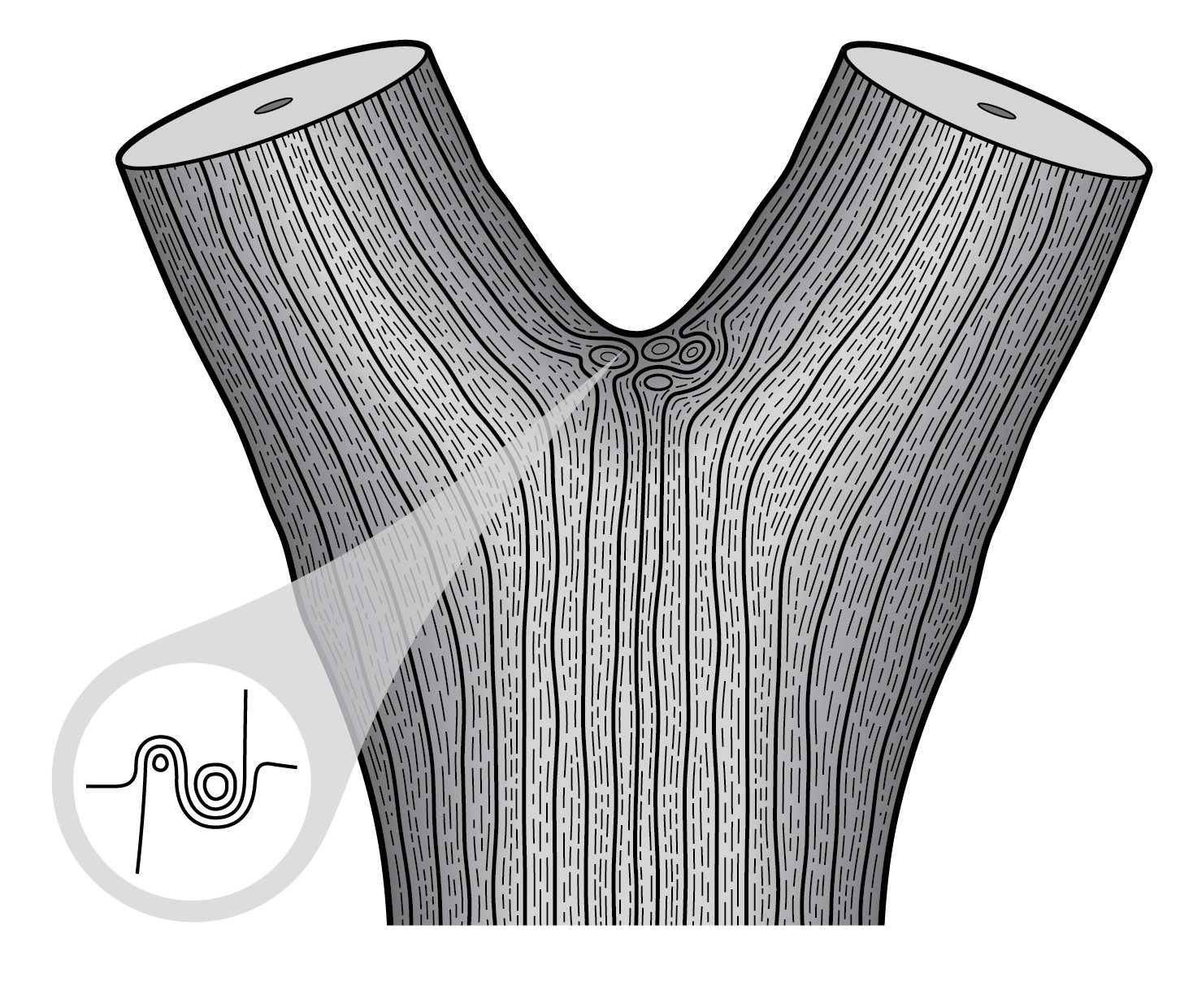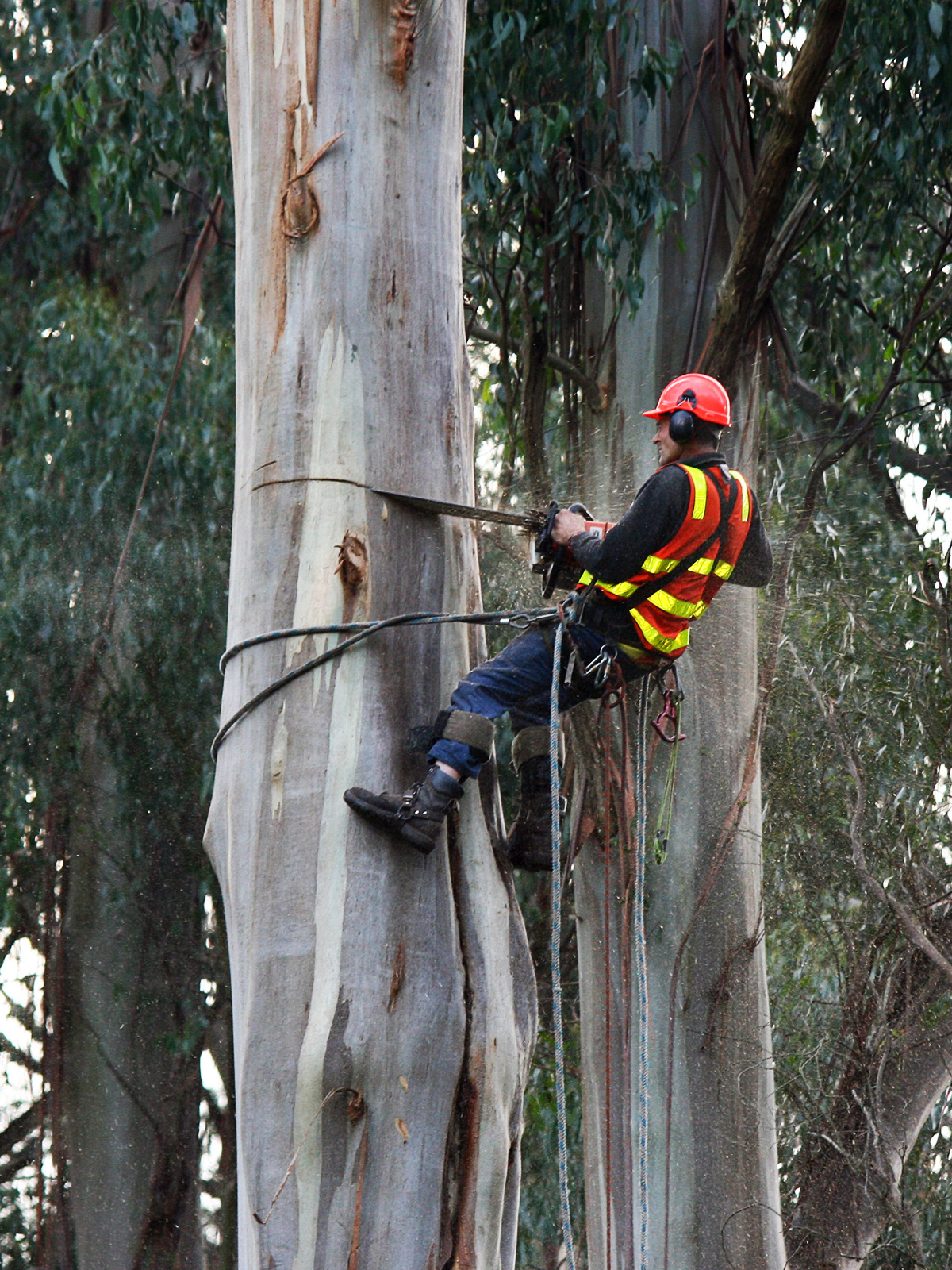|
Tree Fork
A tree fork is a bifurcation in the trunk of a tree giving rise to two roughly equal diameter branches. These forks are a common feature of tree crowns. The wood grain orientation at the top of a tree fork is such that the wood's grain pattern most often interlocks to provide sufficient mechanical support. A common "malformation" of a tree fork is where bark has formed within the join, often caused by natural bracing occurring higher up in the crown of the tree, and these bark-included junctions often have a heightened risk of failure, especially when bracing branches are pruned out or are shaded out from the tree's crown. Definition In arboriculture, junctions in the crown structure of trees are frequently categorised as either branch-to-stem attachments or co-dominant stems. Co-dominant stems are where the two or more arising branches emerging from the junction are of near equal diameter and this type of junction in a tree is often referred to in layman's terms as 'a tree ... [...More Info...] [...Related Items...] OR: [Wikipedia] [Google] [Baidu] |
Tree
In botany, a tree is a perennial plant with an elongated stem, or trunk, usually supporting branches and leaves. In some usages, the definition of a tree may be narrower, including only woody plants with secondary growth, plants that are usable as lumber or plants above a specified height. In wider definitions, the taller palms, tree ferns, bananas, and bamboos are also trees. Trees are not a taxonomic group but include a variety of plant species that have independently evolved a trunk and branches as a way to tower above other plants to compete for sunlight. The majority of tree species are angiosperms or hardwoods; of the rest, many are gymnosperms or softwoods. Trees tend to be long-lived, some reaching several thousand years old. Trees have been in existence for 370 million years. It is estimated that there are some three trillion mature trees in the world. A tree typically has many secondary branches supported clear of the ground by the trunk. This trunk typi ... [...More Info...] [...Related Items...] OR: [Wikipedia] [Google] [Baidu] |
Pruning
Pruning is a horticultural, arboricultural, and silvicultural practice involving the selective removal of certain parts of a plant, such as branches, buds, or roots. The practice entails the ''targeted'' removal of diseased, damaged, dead, non-productive, structurally unsound, or otherwise unwanted plant material from crop and landscape plants. Some try to remember the categories as "the 4 D's": the last general category being "deranged". In general, the smaller the branch that is cut, the easier it is for a woody plant to compartmentalize the wound and thus limit the potential for pathogen intrusion and decay. It is therefore preferable to make any necessary formative structural pruning cuts to young plants, rather than removing large, poorly placed branches from mature plants. In nature, meteorological conditions such as wind, ice and snow, and salinity can cause plants to self-prune. This natural shedding is called abscission. Specialized pruning practices may be ... [...More Info...] [...Related Items...] OR: [Wikipedia] [Google] [Baidu] |
Forest Management
Forest management is a branch of forestry concerned with overall administrative, legal, economic, and social aspects, as well as scientific and technical aspects, such as silviculture, protection, and forest regulation. This includes management for timber, aesthetics, recreation, urban values, water, wildlife, inland and nearshore fisheries, wood products, plant genetic resources, and other forest resource values. Management objectives can be for conservation, utilisation, or a mixture of the two. Techniques include timber extraction, planting and replanting of different species, building and maintenance of roads and pathways through forests, and preventing fire. Definition The forest is a natural system that can supply different products and services. Forests supply water, mitigate climate change, provide habitats for wildlife including many pollinators which are essential for sustainable food production, provide timber and fuelwood, serve as a source of non-wood forest pr ... [...More Info...] [...Related Items...] OR: [Wikipedia] [Google] [Baidu] |
Trees
In botany, a tree is a perennial plant with an elongated stem, or trunk, usually supporting branches and leaves. In some usages, the definition of a tree may be narrower, including only woody plants with secondary growth, plants that are usable as lumber or plants above a specified height. In wider definitions, the taller palms, tree ferns, bananas, and bamboos are also trees. Trees are not a taxonomic group but include a variety of plant species that have independently evolved a trunk and branches as a way to tower above other plants to compete for sunlight. The majority of tree species are angiosperms or hardwoods; of the rest, many are gymnosperms or softwoods. Trees tend to be long-lived, some reaching several thousand years old. Trees have been in existence for 370 million years. It is estimated that there are some three trillion mature trees in the world. A tree typically has many secondary branches supported clear of the ground by the trunk. This trunk typic ... [...More Info...] [...Related Items...] OR: [Wikipedia] [Google] [Baidu] |
Da Vinci Branching Rule
Patterns in nature are visible regularities of form found in the natural world. These patterns recur in different contexts and can sometimes be modelled mathematically. Natural patterns include symmetries, trees, spirals, meanders, waves, foams, tessellations, cracks and stripes. Early Greek philosophers studied pattern, with Plato, Pythagoras and Empedocles attempting to explain order in nature. The modern understanding of visible patterns developed gradually over time. In the 19th century, the Belgian physicist Joseph Plateau examined soap films, leading him to formulate the concept of a minimal surface. The German biologist and artist Ernst Haeckel painted hundreds of marine organisms to emphasise their symmetry. Scottish biologist D'Arcy Thompson pioneered the study of growth patterns in both plants and animals, showing that simple equations could explain spiral growth. In the 20th century, the British mathematician Alan Turing predicted mechanisms of morphogenesis ... [...More Info...] [...Related Items...] OR: [Wikipedia] [Google] [Baidu] |
Branch Collar
A branch collar is the "shoulder" between the branch and trunk of woody plants; the inflammation formed at the base of the branch is caused by annually overlapping trunk tissue. The shape of the branch collar is due to two separate growth patterns, initially the branch grows basipetally, followed by seasonal trunk growth which envelops the branch. Branch collars serve as a strong foundation to the branch, and its orientation and internal characteristics allow the branch to withstand stress from numerous directions. Functionally the branch collars also influence the conductivity of nutrients and growth patterns. The branch collar which provides a protective barrier to prevent infection and decay, can also be useful in diagnosing bacterial diseases. Proper pruning techniques should accommodate for the branch collar structure, as by damaging the tree it is likely to decay or become diseased. Definition In arboriculture, the "shoulder" junction structure between the branch and ... [...More Info...] [...Related Items...] OR: [Wikipedia] [Google] [Baidu] |
Branch Attachment
A branch attachment is where a branch is attached to the trunk of a tree. Three types of branch attachment are recognized due to differences in the anatomical position of buds that form them. Two key components contribute to the mechanical strength and toughness of the attachment: interlocking wood grain at the top of the attachment and an embedded knot that often lies within the attachment. A common malformation of a branch attachment is the inclusion of bark within the join, which can weaken the attachment. Anatomy in trees Initially branches are mechanically attached to the trunks of trees by forming interlocking wood grain patterns at the top of the joint, within what is known as 'axillary wood' (Fig. 1).Slater, D. and Ennos, A. R. (2015) Interlocking wood grain patterns provide improved wood strength in forks of hazel (''Corylus avellana'' L.), ''Arboricultural Journal'' 37 (1) 1-12 The axillary wood (or xylem) formed in this location is denser than in surrounding tissue ... [...More Info...] [...Related Items...] OR: [Wikipedia] [Google] [Baidu] |
Biomimicry
Biomimetics or biomimicry is the emulation of the models, systems, and elements of nature for the purpose of solving complex human problems. The terms "biomimetics" and "biomimicry" are derived from grc, βίος (''bios''), life, and μίμησις ('' mīmēsis''), imitation, from μιμεῖσθαι (''mīmeisthai''), to imitate, from μῖμος (''mimos''), actor. A closely related field is bionics. Living organisms have evolved well-adapted structures and materials over geological time through natural selection. Biomimetics has given rise to new technologies inspired by biological solutions at macro and nanoscales. Humans have looked at nature for answers to problems throughout their existence. Nature has solved engineering problems such as self-healing abilities, environmental exposure tolerance and resistance, hydrophobicity, self-assembly, and harnessing solar energy. History One of the early examples of biomimicry was the study of birds to enable human flight. Al ... [...More Info...] [...Related Items...] OR: [Wikipedia] [Google] [Baidu] |
Arboriculture
Arboriculture () is the cultivation, management, and study of individual trees, shrubs, vines, and other perennial woody plants. The science of arboriculture studies how these plants grow and respond to cultural practices and to their environment. The practice of arboriculture includes cultural techniques such as selection, planting, training, fertilization, pest and pathogen control, pruning, shaping, and removal. Overview A person who practices or studies arboriculture can be termed an '' arborist'' or an ''arboriculturist''. A '' tree surgeon'' is more typically someone who is trained in the physical maintenance and manipulation of trees and therefore more a part of the arboriculture process rather than an arborist. Risk management, legal issues, and aesthetic considerations have come to play prominent roles in the practice of arboriculture. Businesses often need to hire arboriculturists to complete "tree hazard surveys" and generally manage the trees on-site to f ... [...More Info...] [...Related Items...] OR: [Wikipedia] [Google] [Baidu] |
Zwiesel Baumkuss 20200714 170806
Zwiesel ( cs, Svízel) is a town in the lower-Bavarian district of Regen, and since 1972 is a Luftkurort with particularly good air. The name of the town was derived from the Bavarian word stem "zwisl" which refers to the form of a fork. The fork of the rivers Großer Regen and Kleiner Regen and the land that lies between these two rivers were called Zwiesel. Geography The town of Zwiesel is situated in an extensive valley basin at the foot of the mountain range formed by the peaks of the Großer Arber (1,456 m), Großer Falkenstein (1,315 m) and Kiesruck (1,265 m), exactly at the spot where the two rivers, the Großer Regen and the Kleiner Regen join and form the Black Regen. It is located to the north-east of the district town of Regen, from the town of Deggendorf, from the town of Grafenau and from the border crossing point at Bayerisch Eisenstein, entry point to the Czech Republic. In addition to be accessed by the federal road B11, the town of Zwiesel has a main rai ... [...More Info...] [...Related Items...] OR: [Wikipedia] [Google] [Baidu] |
Bark Inclusion Failure In Hazel Corylus Avellana
Bark may refer to: * Bark (botany), an outer layer of a woody plant such as a tree or stick * Bark (sound), a vocalization of some animals (which is commonly the dog) Places * Bark, Germany * Bark, Warmian-Masurian Voivodeship, Poland Arts, entertainment, and media * ''Bark'' (Jefferson Airplane album), 1971 *Bark (Blackie and the Rodeo Kings album) * ''Bark'' (short story collection), a short story collection by Lorrie Moore * '' Bark!'', a 2002 film * ''Bark!'', a magazine published by Canada Wide Media * Bark the Polar Bear, a character in the ''Sonic the Hedgehog'' series Brands and enterprises * BARK (computer), a computer Food * Almond bark, a confection * Peppermint bark, a confection Science * βARK, Beta adrenergic receptor kinase, an intracellular enzyme * Bark scale, an auditory frequency metric Other uses * Bark or barque A barque, barc, or bark is a type of sailing vessel with three or more masts having the fore- and mainmasts rigged square and onl ... [...More Info...] [...Related Items...] OR: [Wikipedia] [Google] [Baidu] |







